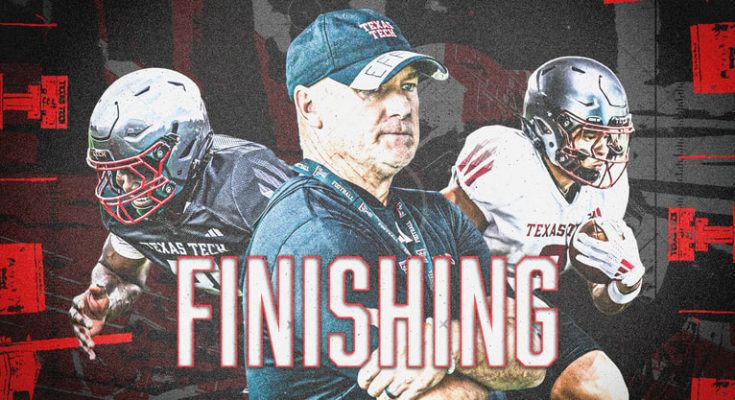Texas Tech University’s football program is entering a critical stage of its preseason preparations as the Red Raiders focus on fine-tuning every detail ahead of their second scrimmage of the season. After weeks of rigorous training, strategy sessions, and conditioning work, the team is now zeroing in on the nuances that could define their performance in the early stages of the upcoming campaign. This period is crucial not only for player development but also for establishing cohesion, refining execution, and solidifying the foundational aspects of their offensive and defensive schemes. Coaches and players alike understand that preseason scrimmages are more than just practice; they are high-stakes opportunities to evaluate talent, assess adjustments, and create a blueprint for success as the competitive season approaches.
The Red Raiders have been operating with a clear vision under the guidance of their coaching staff, who are intent on ensuring that every player is aligned with the team’s overarching goals. Each practice session is designed to simulate game-like conditions, allowing players to experience the intensity and pressure they will face in real contests. For the second scrimmage, the coaching staff has emphasized situational drills that challenge both veterans and newcomers to think critically and execute under stress. These scenarios are carefully constructed to test decision-making, teamwork, and adaptability—qualities that are essential for thriving in a dynamic football environment. Players are being pushed to recognize opportunities, correct mistakes quickly, and maintain consistency in execution, all while maintaining high energy levels and focus.
Offensive preparation has been a central theme in the lead-up to the second scrimmage. The coaching staff has concentrated on refining timing, communication, and precision in the Red Raiders’ offensive sets. Quarterbacks are being challenged to make rapid reads, adjust to defensive pressures, and deliver accurate throws under varying conditions. Receivers are focusing on route sharpness, hand-eye coordination, and the ability to create separation against increasingly sophisticated coverage schemes. Running backs are being tasked with not only improving their vision and agility but also enhancing their pass protection and route-running capabilities. The offensive line, often described as the backbone of any football team, is dedicating significant time to mastering coordination, footwork, and leverage techniques to protect the quarterback and create openings for the running game. Every play, from the simplest handoff to complex passing sequences, is being dissected, analyzed, and refined to ensure maximum efficiency during game situations.
Defensively, the Red Raiders are equally committed to polishing every aspect of their approach. Coaches are emphasizing alignment, gap integrity, and communication across all defensive positions. Linebackers are being tested on their ability to read the offense, anticipate plays, and react with speed and precision. Defensive backs are sharpening their coverage techniques, studying tendencies, and practicing interceptions and pass breakups in high-pressure drills. The defensive line is concentrating on penetration, containment, and maintaining leverage against increasingly aggressive offensive fronts. The second scrimmage provides a vital opportunity to observe how well the defensive units can adapt to real-time challenges, respond to audibles, and maintain discipline while executing complex schemes. Special attention is being paid to situational football, such as third-down stops, red-zone coverage, and tackling efficiency, all of which can be decisive factors in tight contests during the regular season.
Team chemistry and cohesion are also focal points as Texas Tech approaches its second scrimmage. While individual talent is essential, the coaching staff recognizes that success in football ultimately depends on seamless collaboration and mutual trust among players. Leadership dynamics within the squad are being strengthened, with veterans mentoring younger players, guiding them through nuances of position-specific responsibilities, and fostering a culture of accountability. Practices are structured to encourage communication, shared problem-solving, and resilience in the face of mistakes or setbacks. The ability to recover quickly, adjust strategies on the fly, and support one another on the field is being nurtured as a core value, ensuring that the Red Raiders operate as a cohesive unit rather than a collection of individual performers.
Physical conditioning and endurance continue to play a major role in Texas Tech’s preseason agenda. The coaching staff and training team have implemented rigorous strength, speed, and agility programs to ensure players are prepared for the physical demands of both the scrimmage and the full season. Recovery protocols, nutrition, and injury prevention strategies are being carefully monitored to maintain peak performance levels. These preparations are especially important as the second scrimmage often simulates longer stretches of play, challenging players’ stamina, focus, and resilience under fatigue. Maintaining high-intensity performance over extended periods is a key determinant of success, and the Red Raiders are investing significant effort to ensure that physical readiness complements tactical and technical development.
The mental aspect of the game is being treated with equal importance. Coaches are emphasizing situational awareness, mental resilience, and football IQ as players navigate increasingly complex scenarios during practice. Quarterbacks, coordinators, and team leaders are instilling strategies for decision-making under pressure, pattern recognition, and anticipation of opponent tendencies. Mental toughness is being cultivated not only to handle adversity during scrimmages but also to thrive under the stress of competitive matchups. Visualization techniques, film study, and scenario-based discussions are being incorporated to help players internalize key principles and react instinctively when situations unfold rapidly on the field.
The second scrimmage is also serving as a crucial evaluative tool for the coaching staff. Performance metrics, player rotations, and execution effectiveness are being analyzed in real-time to make informed decisions about depth charts, positional battles, and tactical adjustments. Coaches are able to observe players in near-game conditions, assess strengths and weaknesses, and implement targeted feedback immediately. This iterative approach ensures that areas requiring improvement are addressed promptly, enhancing the team’s overall readiness as the regular season draws closer. Moreover, the scrimmage environment allows for experimentation with new schemes, formations, and play-calling strategies, providing valuable insights into what works best against various defensive or offensive looks.
Recruitment and player development also benefit indirectly from these preparations. As players demonstrate commitment, skill, and adaptability during scrimmages, the program strengthens its reputation for developing talent and fostering competitive excellence. Younger players or transfers have an opportunity to showcase their potential, earn playing time, and contribute meaningfully to the team’s success. This dynamic fosters a culture of meritocracy and motivation, ensuring that every member of the roster understands the importance of preparation, performance, and continuous improvement.
Fan engagement and community support are an underlying, yet powerful, element of Texas Tech’s preparation process. While the scrimmages themselves may be closed or partially open, the anticipation generated among fans underscores the significance of these preseason events. Supporters are eager to see how returning stars perform, which newcomers emerge as contributors, and how the team’s strategy is evolving. Maintaining transparency in preparation, highlighting player progress, and showcasing the team’s dedication to excellence helps strengthen the bond between the program and its fan base, creating a positive environment that extends beyond the field.
In summary, Texas Tech’s approach leading into the second scrimmage reflects a meticulous and comprehensive strategy that balances technical refinement, tactical adjustment, physical conditioning, mental preparation, and team cohesion. The coaching staff’s focus on every detail—from individual skill development to situational execution—demonstrates a commitment to excellence that will define the Red Raiders’ performance in the early stages of the season. As players step onto the field for the second scrimmage, they carry not only the lessons from countless hours of practice but also the expectations of a program determined to compete at the highest level. Every drill, every play, and every interaction contributes to a foundation designed to withstand the rigors of competitive football, positioning Texas Tech to enter the season with confidence, cohesion, and a clear vision of success. The second scrimmage is more than a practice; it is a critical juncture in the Red Raiders’ journey, a moment where preparation meets execution, and where the team’s identity, resilience, and readiness are tested in real time. As the Red Raiders continue to refine their craft, this pivotal event promises to be a showcase of their growth, a reflection of their dedication, and a preview of the impact they intend to make in the season ahead.



